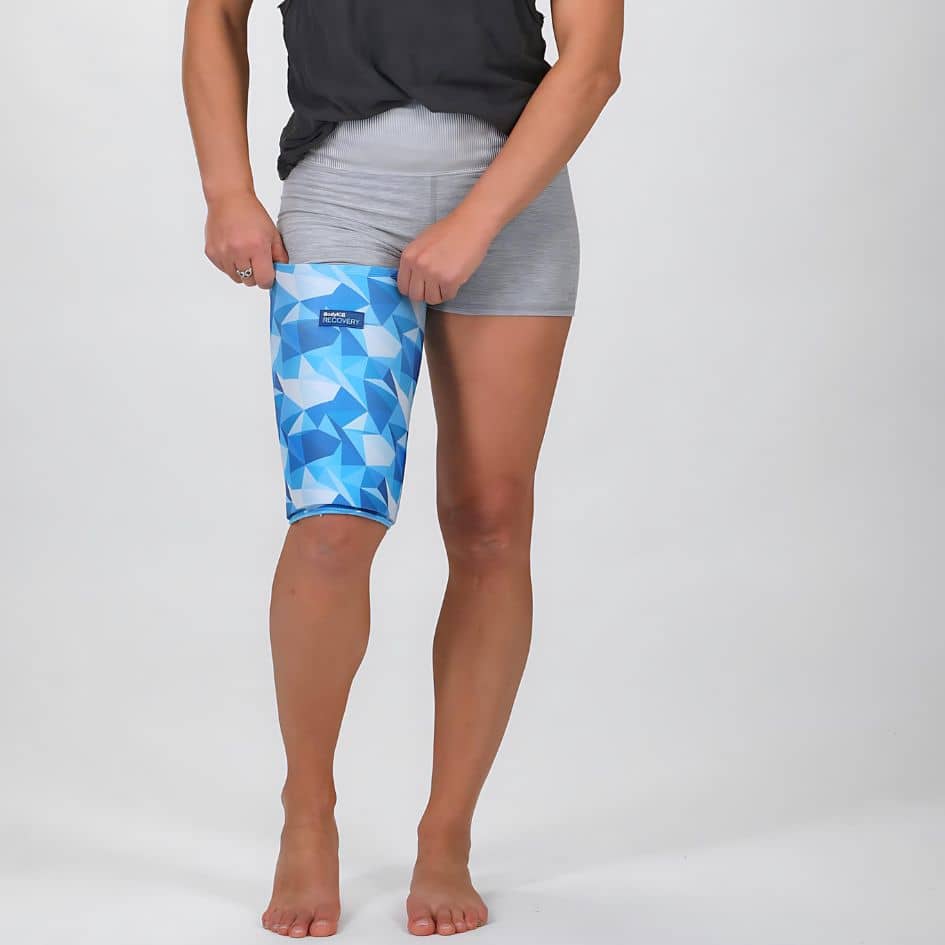Back pain is a common problem that affects millions of people worldwide. It can be caused by various factors, such as muscle strain, poor posture, or injury. When it comes to alleviating back pain, many people turn to ice packs or heat packs for relief. However, there is often confusion about when to use a heat pack or a cold pack for back pain?
While both methods can provide some relief, understanding the benefits and limitations of each is crucial. In this article, we will explore the pros and cons of using ice packs and heat packs for back pain and help you determine which option may be more suitable for your specific situation.

The Pros & Cons Of Using An Ice Pack For Back Pain?
Using ice packs or cold compress, also known as cold therapy, can be effective for reducing inflammation, numbing the area, and providing temporary pain relief. Here are some of the benefits of using a cold pack for back pain:
1. Reduces inflammation: Cold therapy constricts blood vessels, reducing blood flow to the affected area and decreasing inflammation.
2. Numbs the area: The application of ice packs can numb pain signals, providing immediate relief from pain and discomfort and reducing the need for analgesic medication.
3. Reduces swelling: Cold therapy can help reduce swelling, which is often associated with back pain.
However, it's important to note that cold treatment may not be suitable for everyone. Some limitations of using ice packs include:
1. Limited effectiveness for chronic pain: Ice packs may provide temporary relief for acute injuries or flare-ups, but they may not be as effective for chronic back pain for several reasons. Firstly, chronic back pain is often caused by underlying conditions such as arthritis or nerve damage, which may not be effectively treated by cold therapy alone. These conditions require a comprehensive treatment plan that addresses the root cause of the pain. Additionally, cold therapy may not be suitable for certain back injuries. It is generally recommended to avoid using cold therapy for open wounds or skin conditions as it can potentially worsen or delay the healing process.
2. Risk of ice burn: Applying ice directly to the skin for an extended period can lead to and ice burn and temporary skin or tissue damage. It's important to use a protective barrier between the ice pack and your skin and to not leave the ice pack on for more time than is recommended.
Selecting The Right Ice Pack For Back Pain?
When selecting an appropriate ice pack for back pain, avoid using plastic bags of ice, frozen towels or frozen vegetables [you're better off eating those]! Instead, opt for an area specific reusable back ice pack that is easy to administer, stays in place, is comfortable to use and will be a more effective treatment for long term management. Apply the cold compress or ice pack to the affected area for about 15-20 minutes.
The Pros & Cons Of Using A Heat Pack For Back Pain?
Heat therapy, using heat packs, hot water bottles or heating pads can also provide relief from back pain. Here are some benefits of using heat packs:
1. Relaxes muscles: Heat helps to relax muscles, which can be beneficial for relieving muscle pain, tension and spasms.
2. Increases blood flow: Heat therapy increases blood flow to the affected area and areas of poor circulation which can promote tissue healing and reduce stiffness.
3. Soothes pain: Heat can provide a soothing sensation and help alleviate pain and discomfort reducing the need for analgesic medication.
However, heat packs also have their limitations. Here are a few things to consider:
1. Not suitable for acute injuries: Heat treatment is not recommended for acute injuries where inflammation and swelling is present, as it can increase blood flow and potentially worsen swelling.
2. Risk of burns: It's important to use heat packs with caution and avoid applying excessive heat or leaving them on for too long, as it can lead to burns.
Selecting The Right Heat Pack For Back Pain?
There are many types of heat therapy such as sauna, a warm bath but sometimes it's quicker and easier to apply a hot pack directly to your back. Our BodyICE Back Ice & Heat Pack serves as both an ice pack and a heat pack and is a great option for long term use. For heat therapy, just fill the insulated bag with hot tap water, secure the lid and secure the pack in place using the neoprene strap. Enjoy the soothing relief without having to hold anything in place! Apply the hot pack to the affected area for about 15-20 minutes.

When To Use A Heat Pack or Cold Pack For Back Pain:
Now that we have explored the benefits and limitations of ice packs and heat packs, it's important to understand when to use each method. Here we take a look at some common conditions and general guidelines for when to us ice or heat:
Ice packs are best used when:
- There is acute pain or inflammation due to an injury or flare-up.
- Swelling is present.
- Immediate relief and numbing of the area is desired.
Back injuries that may benefit from cold therapy include:
- Muscle Strains: Cold therapy can help alleviate pain and swelling associated with strained back muscles and soft tissue injuries.
- Sprained Ligaments: Injuries to the ligaments supporting the spine can benefit from cold therapy to reduce inflammation.
- Herniated Discs: Cold packs may help manage pain and inflammation related to acute herniated or bulging discs.
- Facet Joint Injuries: Injuries to the small joints between vertebrae can be eased with cold therapy.
- Compression Fractures: Cold packs can be used to manage pain and swelling caused by fractures in the vertebrae.
- Sciatica: Cold therapy can help alleviate the inflammation and pain associated with sciatic nerve compression.
- Scoliosis Discomfort: While not a direct treatment for scoliosis, cold therapy can provide relief from associated muscle discomfort.
- Post-Surgical Recovery: Cold therapy is often used in the post-surgical phase for natural pain relief and to reduce swelling.
- Spinal Cord Injuries: Cold therapy is a promising neuroprotective treatment for acute spinal cord injury. However, the best outcomes are usually seen when cold therapy is combined with other treatments like decompression surgery and medications. There has yet to be any sort of standardisation for cold therapy after spinal cord injury, so it is still very much an experimental treatment.

Heat packs are best used when:
- There is muscle tension or spasms.
- The pain is chronic or ongoing.
- Relaxation and soothing of the area is desired.
Back injuries that may benefit from heat therapy include:
- Arthritis: Heat can provide relief for individuals with arthritis in the spine by reducing stiffness and promoting flexibility.
- Chronic Back Pain: Conditions causing persistent back pain, such as degenerative disc disease, may benefit from heat therapy for ongoing relief.
- Herniated Discs: Heat can help relax muscles and reduce pain associated with chronic herniated or bulging discs.
- Osteoarthritis: For those with degenerative changes in the spine, heat therapy can help manage pain and stiffness.
- Muscle Spasms: Heat can be effective in relaxing muscles and relieving spasms in the back.
- Sacroiliac Joint Dysfunction: Conditions affecting the sacroiliac joint, leading to pain in the lower back, may find relief with heat therapy.
- Fibromyalgia: Individuals with fibromyalgia may use heat therapy to manage widespread pain, including in the back.
-
Post-Exercise Soreness: After engaging in physical activity, applying heat can help relax muscles and ease post-exercise soreness.

Alternating hot and cold therapy
Alternating hot and cold therapy, also known as contrast therapy, can offer several benefits for managing back pain. This approach involves using both heat and cold treatments in sequence to take advantage of their respective therapeutic effects. Here are the benefits of alternating hot and cold therapy for back pain:
- Reduced Inflammation: Cold therapy (ice) helps constrict blood vessels, reducing blood flow to the affected area and minimising inflammation. As mentioned above, this can be beneficial for acute back pain or injuries.
- Pain Relief: Cold therapy can numb the affected area, providing temporary pain relief. This is especially useful for managing pain associated with inflammation from injuries caused by acute or sports injuries.
- Muscle Relaxation: Heat therapy helps to increase blood flow and relax muscles. This can alleviate muscle tension and stiffness, common contributors to back pain.
- Improved Circulation: Alternating between hot and cold applications enhances blood circulation. Increased blood flow brings oxygen and nutrients to the affected area, promoting healing.
- Promotion of Healing: Heat therapy encourages cellular metabolism and accelerates the healing process. It is particularly useful for chronic conditions or injuries that have entered the later stages of healing.
- Enhanced Flexibility: Alternating between hot and cold treatments can improve flexibility and range of motion. This is beneficial for individuals with back pain due to muscle tightness or stiffness.
-
Versatility in Treatment: Contrast therapy provides a versatile approach that can be adapted to different stages of an injury or various types of back pain. It allows individuals to tailor their treatment based on symptoms.
How to Apply Alternating Hot and Cold Therapy:
- Start with Cold: Apply a cold compress or ice pack to the affected area for about 15-20 minutes.
- Follow with Heat: Apply a warm compress or hot pack to the same area for 15-20 minutes.
- Repeat: Continue to alternate between hot and cold treatments for a total treatment time of 45-60 minutes.
Ultimately, the effectiveness of ice or heat therapy can vary among individuals, and personal preference plays a role. Some may find more relief with one over the other, and trial and error can help determine the most effective method for managing symptoms and including it into your daily routine. If in doubt, seeking guidance from a healthcare provider is recommended to help determine which method is best for your specific situation. It's also important to consult with a physical therapist in your area that can help you with active exercise to strengthen, stabilise and guide your through your rehabilitation process.
The cold wrap
Both ice packs and heat packs can provide relief for back pain, but they have different benefits and limitations. Understanding when to use each method can help you effectively manage your back pain and find the most suitable option for your needs. Remember to use caution, follow guidelines, and seek professional advice if needed.

For effective relief of back pain, check out our reusable ice packs and heat packs. We have a back specific design for all musculoskeletal injuries for back and hip regions. Get your heat or cold pack for back pain here!






















Leave a comment
All comments are moderated before being published.
This site is protected by hCaptcha and the hCaptcha Privacy Policy and Terms of Service apply.